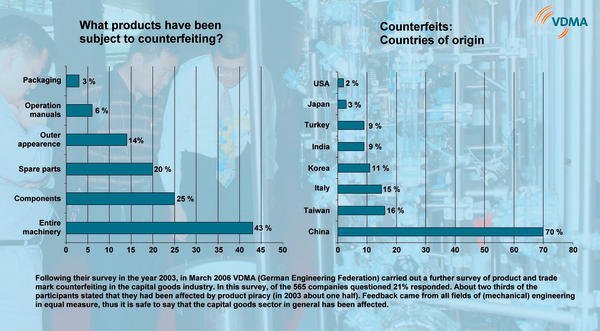Since its economic opening in the early eighties, China has emerged as the world’s global powerhouse for the production of industrial and consumer goods. Parallel to this development, China has unfortunately also become the worldwide hub for brand piracy and copied products.
Thomas Scheuring
Two thirds of all confiscated copy products worldwide are of Chinese origin. There is no industry branch or product segment which is not affected, and the economic damages to brand and patent owners are immeasurable.
Copying is frequently attributed to the Chinese mentality, which is likely to consider it a compliment to the original rather than a violation of property rights. Maybe more realistically, copying is simply a quick way to make money. Or, on a larger commercial scale, to catch up with the industrialised economies and their 200-year historical lead – compared to less than 30 years since industrialisation first got under way in China. Today, of course, we are no longer talking merely about cheap mass articles or consumer goods: even the most high-tech products are susceptible to copying.
Changed situation
The situation has changed since China’s accession to the WTO, however. First of all, it is clear that a country which educates 400,000 highly qualified engineers a year will also produce its own innovations. And it is in the country’s own natural interest to protect these innovations. The same holds true for the dozens of strong brand names of Chinese origin which already dominate the home market and are about to take the world by storm. 2005 was the first year in which more patents were issued to domestic companies in China than to foreign ones. The lawyers employed by these firms definitely have no sense of humour when it comes to violations of their brand rights. Furthermore, it is essential for the country to rid itself of its bad reputation as the world’s number one copy manufacturer, as this severely affects China’s international trade relations.
The crowd-pulling destructions of confiscated, illegal CDs regularly undertaken by China’s Anti-Piracy Committee are hence more than just activism staged for the TV cameras – they are evidence of a clearly expressed political will. It is no accident that Chinese legislation has adopted many key elements of German patent law. China has also signed both the Madrid and the Paris agreements on the international protection of patents and trademarks. The legal framework, in other words, contains sufficient clout to fight intellectual property violations. Chinese law provides for sentences of up to seven years imprisonment for severe cases of infringement, for example. Admittedly, administrative action and enforcement still lacks efficiency, and the offences actually alleged may only be the tip of the iceberg.
Chinese officials often emphasise how important it is that foreign companies actually prosecute every disclosed violation of their name rights or patents. There are many false tales about the difficulty of successfully going to court in the People’s Republic. Contrary to popular belief, the courts in most of China’s major cities have a special chamber for the protection of intellectual property rights, headed by judges with a scientific or technical education on top of their degree in law. Providing you have applied for your patent or brand name in China in due time before the violation took place, it is definitely not a hopeless venture to bring your case to trial.
Not a never-ending story
In 2005, the number of judicial cases concerning intellectual property rights heard at Chinese courts exceeded the 10,000 mark for the first time. Eighty percent of all cases involving a non-Chinese party were won by the foreign side. And in contrast to many courts in Western countries, legal proceedings in China are not a never-ending story: after two instances, there is no further opportunity for appeal. On the other hand, interim injunctions are difficult to achieve – they are notoriously uncommon in China, with just 175 being issued nationwide last year. In any case, it is highly recommended to produce a nationalised and notarised version of your patent or trademark document – and to have it available when participating at an exhibition or trade fair, for instance. Finally: it can’t be emphasised enough how important it is to invest in a comprehensive portfolio of patent and name rights which cover all your essential brand names and technical products in China – even if your first reaction is that this simply means putting extra money in the bureaucrats pockets!
Share:







